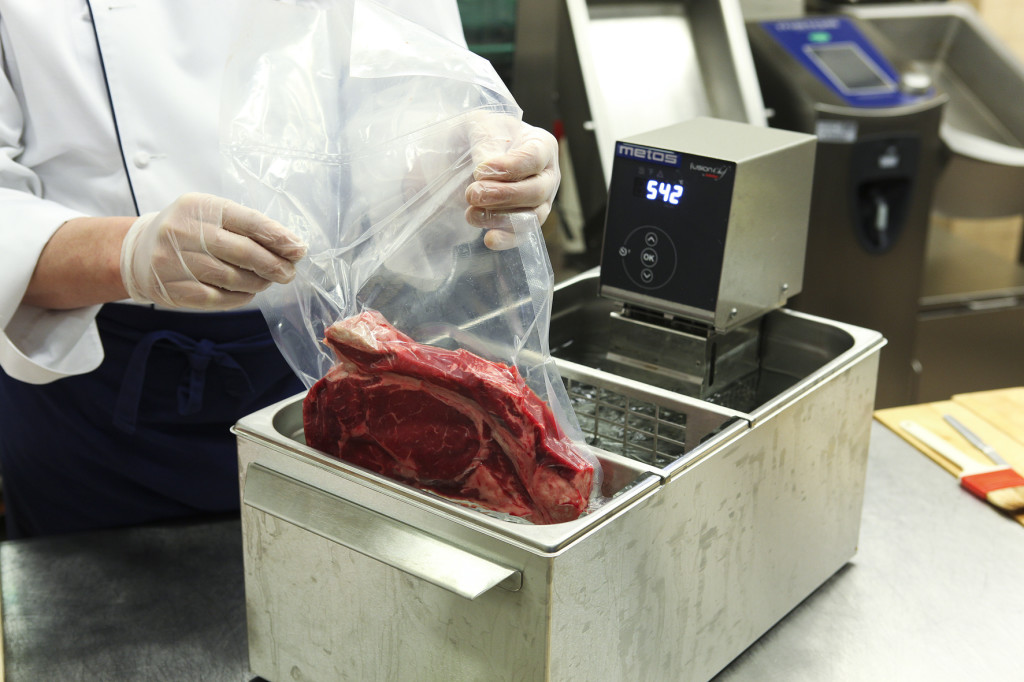Cooking sous vide syle is much easier than its fancy name might suggest once you’ve heard it. You will need to simply seal the ingredients in a plastic bag that’s safe for cooking and you can also use a canning jar. After that, you need to place them in a water bath, a combi oven could also work, or any other cooker that can just set and hold the target temperature to a degree or two. When the food reaches your target time or temperature, you can take it out from the water bath and then give it a quick sear or other finish, and then serve it. Thats it. So,why cook sous vide?
Sous vide is useful for cooking seafood and meats, for which the window of proper doneness which is often vanishingly small when your cooking with the traditional methods. When you’re frying a piece of fish, the flesh is more tender and succulent within a very narrow temperature range. Because the cooking temperature of the pan is usually at least 200 °C / 392 °F hotter than the ideal temperature of what you’re cooking, the edges of the fish will inevitably be more cooked than the insides and center when cooked pan-fried.
The chicken breasts and and poultry products or other poultry cuts are usually held at a target temperature for different reason, which is to kill any potential pathogens and to improve the safety of the food.
The idea of preserving food and cooking food in sealed packages is ancient. Throughout the culinary history, food that has been wrapped in leaves, potted and wrapped in fat, packed with a bunch of salt, or sealed inside an animal bladder before its been cooked. People have long known that isolating food from air accomplished more completely by vacuum sealing, can arrest the decay of food. Packaging food also prevents it from drying out. 
Sous vide means ”under vacuum” in French, the defining feature of the sous vide cooking method is not packaging or vacuum sealing; it is cooking within the accurate temperature control. A computer-controlled heater can warm a water bath to any low temperature you set, and it can also keep it there for more hoursor even days, if needed.
Such mastery over the heat pays off in several important ways, mostly, freeing the cook from the tyranny of his clock. The traditional cooking within a range, combi oven, or grilling uses high and usually fluctuating temperatures, so you must keep time of the cooking to cook it exactly; there is just a little margin for any error. With just moments inattention, conventional cooking can quickly overshoot perfection.
When cooking sous vide method, in contrast, most of the foods will taste as good even if they spend few extra minutes at the target temperature, so this means you can still relax and devote your attention to the more interesting and creative aspects of cooking.
Precise temperature control and uniformity of the temperature has two other big benefits. First, it allows you to cook your food to an even doneness all the way through the food, there will be no dry edges and rare insides or centers. Second, you can get highly repeatable results. The steak emerges from the bag juicy and pink every time.
The final important benefit is that the closed bag creates a humid environment that is effectively braising the food, so that the ingredients cooked within this way are often juicier and more tender. The food cooked sous vide style doesn’t brown, but it simple sears and adds that traditional flavor where its needed so that you can have the best of both worlds.
We have been asked many times about the safety of cooking plastic bags. The bottom line is that bags made expressly for cooking sous vide are perfectly safe as are oven bags, popular brands of zip-top bags, and stretchy plastic wrap such as Saran Wrap.
The plastic that these products are made of is called polyethylene. It is widely used in containers for biology and chemistry labs, and it has been studied extensively. It is safe. But, do avoid very cheap plastic wraps when cooking. These are made of polyvinyl chloride (PVC), and heating them presents a risk of chemicals leaching into the food.


